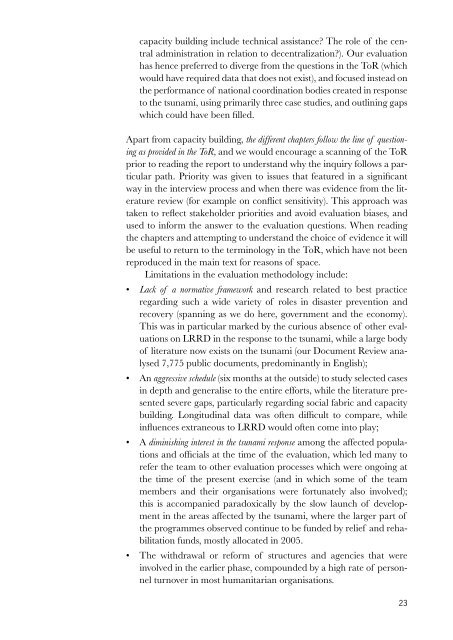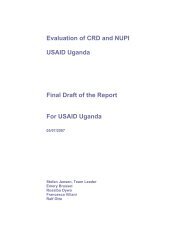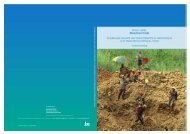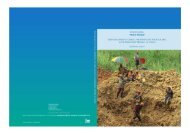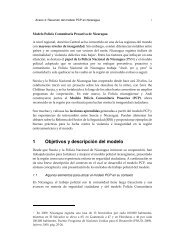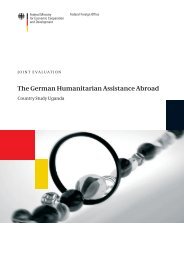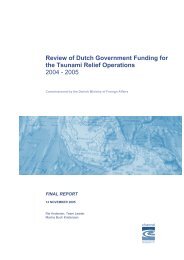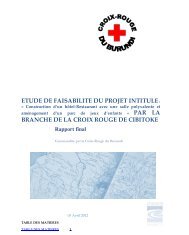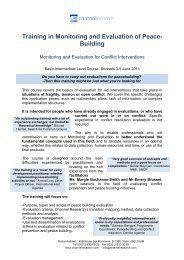A ripple in development? - Channel Research
A ripple in development? - Channel Research
A ripple in development? - Channel Research
Create successful ePaper yourself
Turn your PDF publications into a flip-book with our unique Google optimized e-Paper software.
capacity build<strong>in</strong>g <strong>in</strong>clude technical assistance? The role of the central<br />
adm<strong>in</strong>istration <strong>in</strong> relation to decentralization?). Our evaluation<br />
has hence preferred to diverge from the questions <strong>in</strong> the ToR (which<br />
would have required data that does not exist), and focused <strong>in</strong>stead on<br />
the performance of national coord<strong>in</strong>ation bodies created <strong>in</strong> response<br />
to the tsunami, us<strong>in</strong>g primarily three case studies, and outl<strong>in</strong><strong>in</strong>g gaps<br />
which could have been filled.<br />
Apart from capacity build<strong>in</strong>g, the different chapters follow the l<strong>in</strong>e of question<strong>in</strong>g<br />
as provided <strong>in</strong> the ToR, and we would encourage a scann<strong>in</strong>g of the ToR<br />
prior to read<strong>in</strong>g the report to understand why the <strong>in</strong>quiry follows a particular<br />
path. Priority was given to issues that featured <strong>in</strong> a significant<br />
way <strong>in</strong> the <strong>in</strong>terview process and when there was evidence from the literature<br />
review (for example on conflict sensitivity). This approach was<br />
taken to reflect stakeholder priorities and avoid evaluation biases, and<br />
used to <strong>in</strong>form the answer to the evaluation questions. When read<strong>in</strong>g<br />
the chapters and attempt<strong>in</strong>g to understand the choice of evidence it will<br />
be useful to return to the term<strong>in</strong>ology <strong>in</strong> the ToR, which have not been<br />
reproduced <strong>in</strong> the ma<strong>in</strong> text for reasons of space.<br />
Limitations <strong>in</strong> the evaluation methodology <strong>in</strong>clude:<br />
• Lack of a normative framework and research related to best practice<br />
regard<strong>in</strong>g such a wide variety of roles <strong>in</strong> disaster prevention and<br />
recovery (spann<strong>in</strong>g as we do here, government and the economy).<br />
This was <strong>in</strong> particular marked by the curious absence of other evaluations<br />
on LRRD <strong>in</strong> the response to the tsunami, while a large body<br />
of literature now exists on the tsunami (our Document Review analysed<br />
7,775 public documents, predom<strong>in</strong>antly <strong>in</strong> English);<br />
• An aggressive schedule (six months at the outside) to study selected cases<br />
<strong>in</strong> depth and generalise to the entire efforts, while the literature presented<br />
severe gaps, particularly regard<strong>in</strong>g social fabric and capacity<br />
build<strong>in</strong>g. Longitud<strong>in</strong>al data was often difficult to compare, while<br />
<strong>in</strong>fluences extraneous to LRRD would often come <strong>in</strong>to play;<br />
• A dim<strong>in</strong>ish<strong>in</strong>g <strong>in</strong>terest <strong>in</strong> the tsunami response among the affected populations<br />
and officials at the time of the evaluation, which led many to<br />
refer the team to other evaluation processes which were ongo<strong>in</strong>g at<br />
the time of the present exercise (and <strong>in</strong> which some of the team<br />
members and their organisations were fortunately also <strong>in</strong>volved);<br />
this is accompanied paradoxically by the slow launch of <strong>development</strong><br />
<strong>in</strong> the areas affected by the tsunami, where the larger part of<br />
the programmes observed cont<strong>in</strong>ue to be funded by relief and rehabilitation<br />
funds, mostly allocated <strong>in</strong> 2005.<br />
• The withdrawal or reform of structures and agencies that were<br />
<strong>in</strong>volved <strong>in</strong> the earlier phase, compounded by a high rate of personnel<br />
turnover <strong>in</strong> most humanitarian organisations.<br />
23


